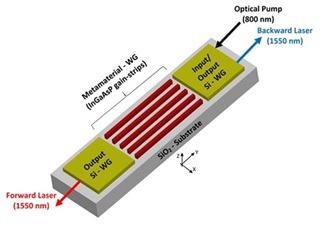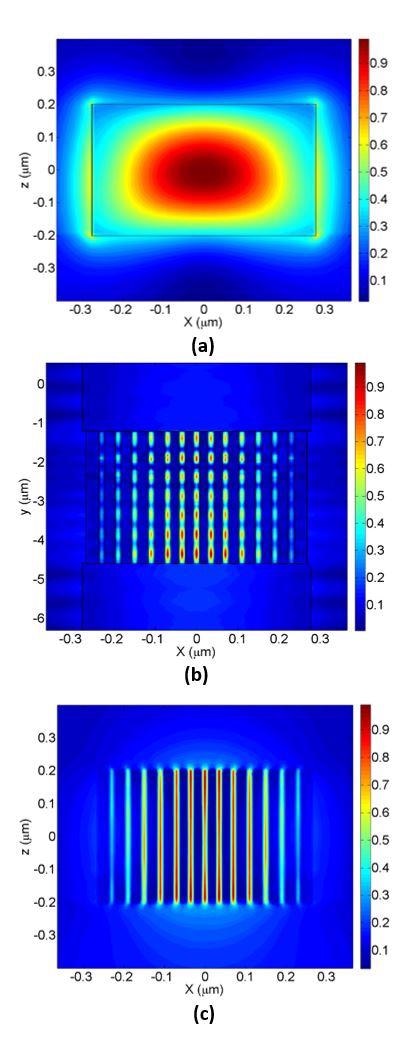A metamaterial nanolaser has many unique properties. But first, we need to take a look at what these materials mean. Metamaterials offer a desired property that is not found naturally. They are usually made from composite materials such as plastics and metals. These are assembled in patterns that are repeated at very small scales and can influence the wavelength.

Image Credit: Crevis/Shutterstock.com
The uniqueness in their structural design leads to the production of smart properties that lead to the handling of different electromagnetic waves by either absorbing, bending, or blocking the waves to achieve desirable properties.
Nanolasers emit light in nanoscale dimensions. They are electrically excited by the application of nanowires or materials on the nanoscale.
Metamaterial Nanolasers
By combining metamaterials and nanolasers, researchers have developed metamaterial nanolasers that have many applications in the optical industry. These are designed in such a way that a metamaterial of any type is used. The metamaterials discussed above have some waveguides which are periodically the stripes and air gaps at the nanoscale. These waveguides are fenced from all the sides by air, leaving only the side below the substrate.

Figure 1: The schematic diagram of metamaterial nanolaser structure indicating different laser parts. Image Credit: Dr. Ehab Awad, King Saud University, Riyadh, Saudi Arabia
Dr. Ehab Awad, from the Electrical Engineering department at the King Saud University, Riyadh, Saudi Arabia, stated:
The gain metamaterial can open the door to have efficient light sources integrated with silicon photonic devices on the same platform.
Horizontally distributed air gaps with gain stripes that are periodically distributed are mainly improved to achieve a useful refractive index of metamaterial that is suitable for the desired application, mainly laser and pump wavelengths.
The gain metamaterial permits for an efficient optical pumping and laser emission, and thus a short length traveling wave nanolaser with a compact size.
Dr. Ehab Awad
Importance of Metamaterial Nanolasers
The importance of metamaterial nanolasers is high considering they are still a developing technology, and the advancements are yet to be achieved more in terms of applications and industrial usage. Metamaterials can now be made with artificial structures or patterns on the nanoscale to build a material that can be used in many applications.
These metamaterial nanolasers can easily generate light at the nanoscale that is coherent, unlike conventional lasers, where compactness and efficiency were a major loophole.
Metamaterial nanolasers have a low amount of threshold regarding optical pumps, better signal-to-noise ratios, a higher amount of internal and external efficiency on a quantum scale, and a shorter laser length consisting of very few microns and a good compact size overall.
Due to the nanolaser and metamaterial’s uniqueness, the threshold limit of a low lasing, higher laser efficiencies, and speeds that are much higher in modulations, metamaterial nanolasers have great potential in many practical sensing applications. Other applications include using nanowires to characterize materials to detect at the lowest optical parameter such as a single molecule with faster modulations and a higher resolution. These properties emphasize why these metamaterial nanolasers are important in optical properties.
Future of Metamaterial Nanolasers
The future looks bright for metamaterial nanolasers. The basic obstacle since the arrival and invention of lasers was their size and how we could manipulate them to be small enough to be placed in electronic chips.
Now, the development of nanotechnology and nanomaterials has given us the metamaterial nanolaser technology for use in such a way that instead of working with photons, researchers have now harnessed the electron clouds known as surface plasmons.

Figure 2: The electric-field profiles of laser signal within different parts of nanolaser: (a) the forward laser in output silicon waveguide, (b) the X–Y cross-section of laser field along nanolaser, and (c) the X–Z cross-section of laser field inside metamaterial waveguide. Image Credit: Image Credit: Dr. Ehab Awad, King Saud University, Riyadh, Saudi Arabia
These electromagnetic waves can be smaller than the visible light’s wavelength. By use of plasmons, these devices overcome the barriers related to the physical shape and lead to nanodevices that could be used in many industries as discussed above. In the future, this could easily lead to many innovations in science, optics and electronics, computers, and health-related applications such as medicine.
The efficient pumping and lasing inside gain metamaterial result in almost ideal internal quantum efficiency of nanolaser.
Dr. Ehab Awad
Current Limitations of Metamaterial Nanolasers
Although the applications and their use are higher in many industries, there are still some challenges to the production of nanolaser technology, including the configuration of cavities and electrically injected nanolasers.
One main weakness is that most nanolasers are still pumped optically as compared to the realization of electrical injection. Moreover, understanding cavity configuration is necessary to develop high-performance nanolasers. This field of interest in terms of metamaterials still requires a lot of research to help develop certain materials that are highly useful in these setups. Research and development and taking this to a higher industrial scale must be followed to overcome and answer the pending questions.
References and Further Reading
Sarychev, A. K., Pukhov, A. A., & Tartakovsky, G. (2007). Metamaterial comprising plasmonic nanolasers. PIERS Online, 3(8), 1264-1267. https://www.piers.org/
Awad, E. (2021). A novel metamaterial gain-waveguide nanolaser. Optics & Laser Technology, 142, 107202. http://dx.doi.org/10.1016/j.optlastec.2021.107202
Shalaginov, M. Y., Chandrasekar, R., Bogdanov, S., Wang, Z., Meng, X., Makarova, O. A., ... & Shalaev, V. M. (2017). Hyperbolic Metamaterials for Single-Photon Sources and Nanolasers. In Quantum Plasmonics (pp. 97-120). Springer, Cham. http://dx.doi.org/10.1007/978-3-319-45820-5_5
Disclaimer: The views expressed here are those of the author expressed in their private capacity and do not necessarily represent the views of AZoM.com Limited T/A AZoNetwork the owner and operator of this website. This disclaimer forms part of the Terms and conditions of use of this website.